Policy Analysis: Social Determinants of Health and Healthcare Access
VerifiedAdded on 2023/06/09
|7
|1593
|318
Report
AI Summary
This policy analysis examines the relationship between the social gradient, a key social determinant of health, and the resulting inequalities in primary healthcare service delivery. It highlights how factors like social exclusion, unemployment, income disparities, and unequal education levels contribute to these inequalities, leading to reduced life expectancy and increased suffering among marginalized populations. The analysis identifies the government as the primary audience and emphasizes the urgent need for policy interventions to ensure equitable access to primary healthcare. Recommendations include formulating policies for resource distribution, improving living conditions, addressing unequal distribution of public funds, and establishing measures to understand and mitigate health inequalities. The analysis concludes that addressing the social gradient is crucial for achieving fairness and justice in healthcare, ultimately improving the health and well-being of all citizens. Desklib offers a platform for students to access similar policy analyses and solved assignments.
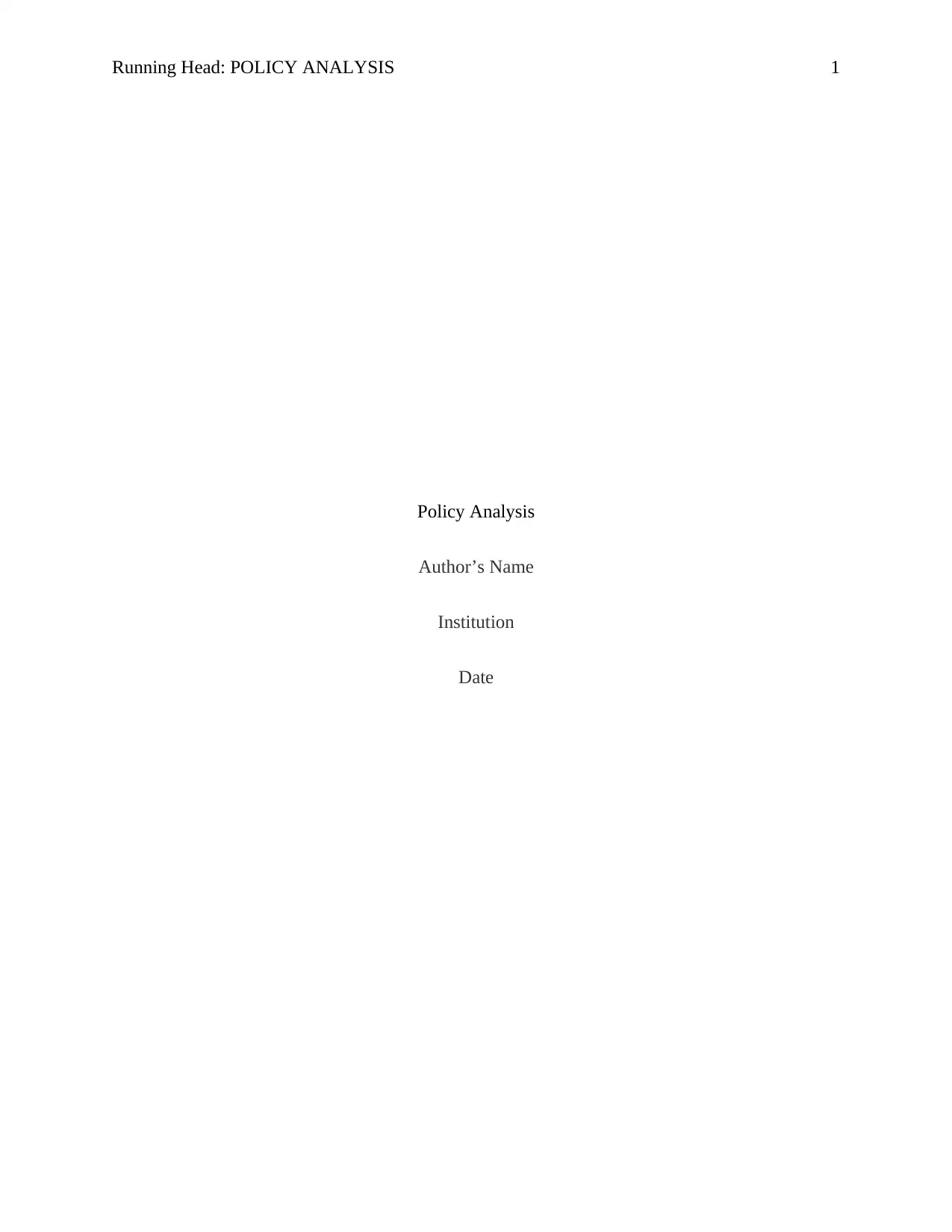
Running Head: POLICY ANALYSIS 1
Policy Analysis
Author’s Name
Institution
Date
Policy Analysis
Author’s Name
Institution
Date
Paraphrase This Document
Need a fresh take? Get an instant paraphrase of this document with our AI Paraphraser
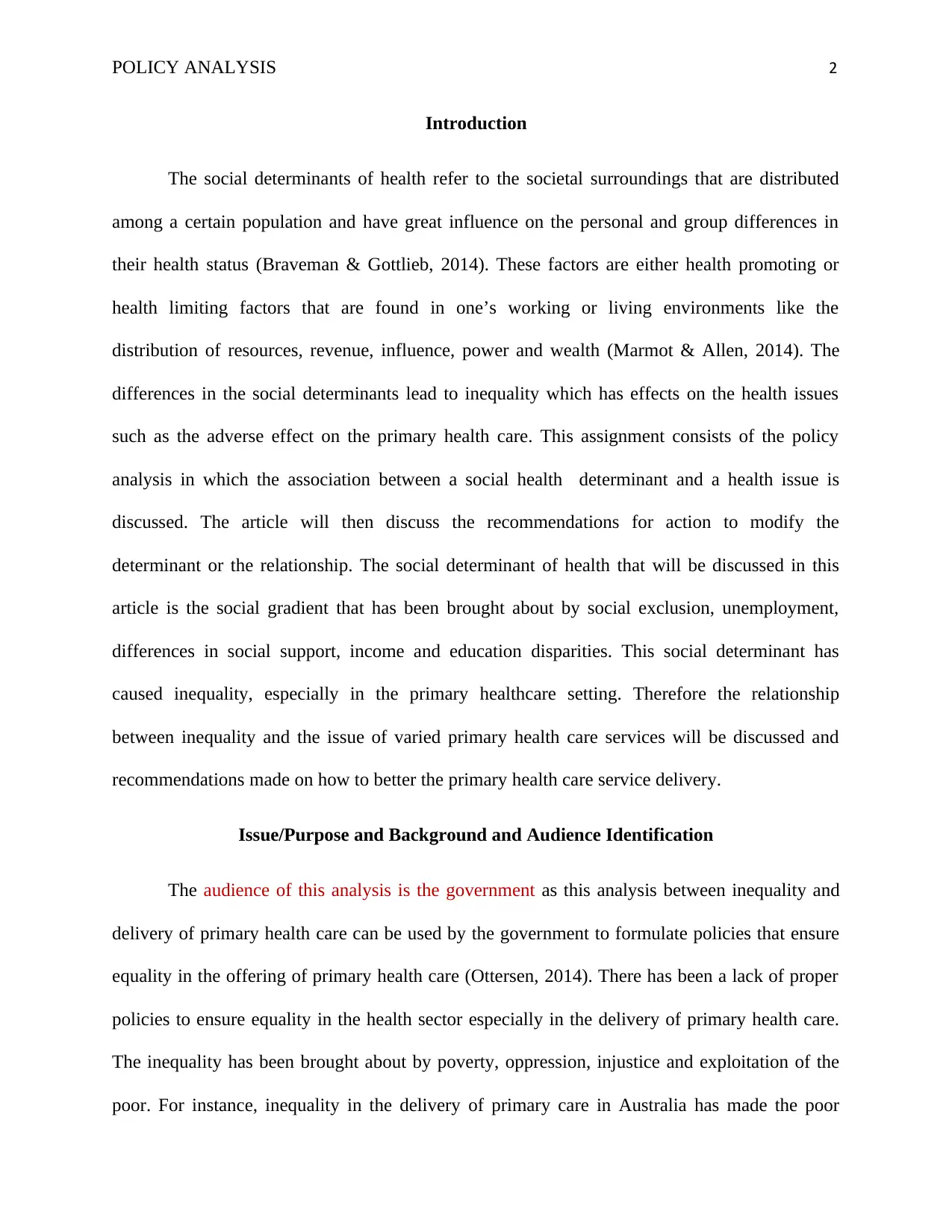
POLICY ANALYSIS 2
Introduction
The social determinants of health refer to the societal surroundings that are distributed
among a certain population and have great influence on the personal and group differences in
their health status (Braveman & Gottlieb, 2014). These factors are either health promoting or
health limiting factors that are found in one’s working or living environments like the
distribution of resources, revenue, influence, power and wealth (Marmot & Allen, 2014). The
differences in the social determinants lead to inequality which has effects on the health issues
such as the adverse effect on the primary health care. This assignment consists of the policy
analysis in which the association between a social health determinant and a health issue is
discussed. The article will then discuss the recommendations for action to modify the
determinant or the relationship. The social determinant of health that will be discussed in this
article is the social gradient that has been brought about by social exclusion, unemployment,
differences in social support, income and education disparities. This social determinant has
caused inequality, especially in the primary healthcare setting. Therefore the relationship
between inequality and the issue of varied primary health care services will be discussed and
recommendations made on how to better the primary health care service delivery.
Issue/Purpose and Background and Audience Identification
The audience of this analysis is the government as this analysis between inequality and
delivery of primary health care can be used by the government to formulate policies that ensure
equality in the offering of primary health care (Ottersen, 2014). There has been a lack of proper
policies to ensure equality in the health sector especially in the delivery of primary health care.
The inequality has been brought about by poverty, oppression, injustice and exploitation of the
poor. For instance, inequality in the delivery of primary care in Australia has made the poor
Introduction
The social determinants of health refer to the societal surroundings that are distributed
among a certain population and have great influence on the personal and group differences in
their health status (Braveman & Gottlieb, 2014). These factors are either health promoting or
health limiting factors that are found in one’s working or living environments like the
distribution of resources, revenue, influence, power and wealth (Marmot & Allen, 2014). The
differences in the social determinants lead to inequality which has effects on the health issues
such as the adverse effect on the primary health care. This assignment consists of the policy
analysis in which the association between a social health determinant and a health issue is
discussed. The article will then discuss the recommendations for action to modify the
determinant or the relationship. The social determinant of health that will be discussed in this
article is the social gradient that has been brought about by social exclusion, unemployment,
differences in social support, income and education disparities. This social determinant has
caused inequality, especially in the primary healthcare setting. Therefore the relationship
between inequality and the issue of varied primary health care services will be discussed and
recommendations made on how to better the primary health care service delivery.
Issue/Purpose and Background and Audience Identification
The audience of this analysis is the government as this analysis between inequality and
delivery of primary health care can be used by the government to formulate policies that ensure
equality in the offering of primary health care (Ottersen, 2014). There has been a lack of proper
policies to ensure equality in the health sector especially in the delivery of primary health care.
The inequality has been brought about by poverty, oppression, injustice and exploitation of the
poor. For instance, inequality in the delivery of primary care in Australia has made the poor
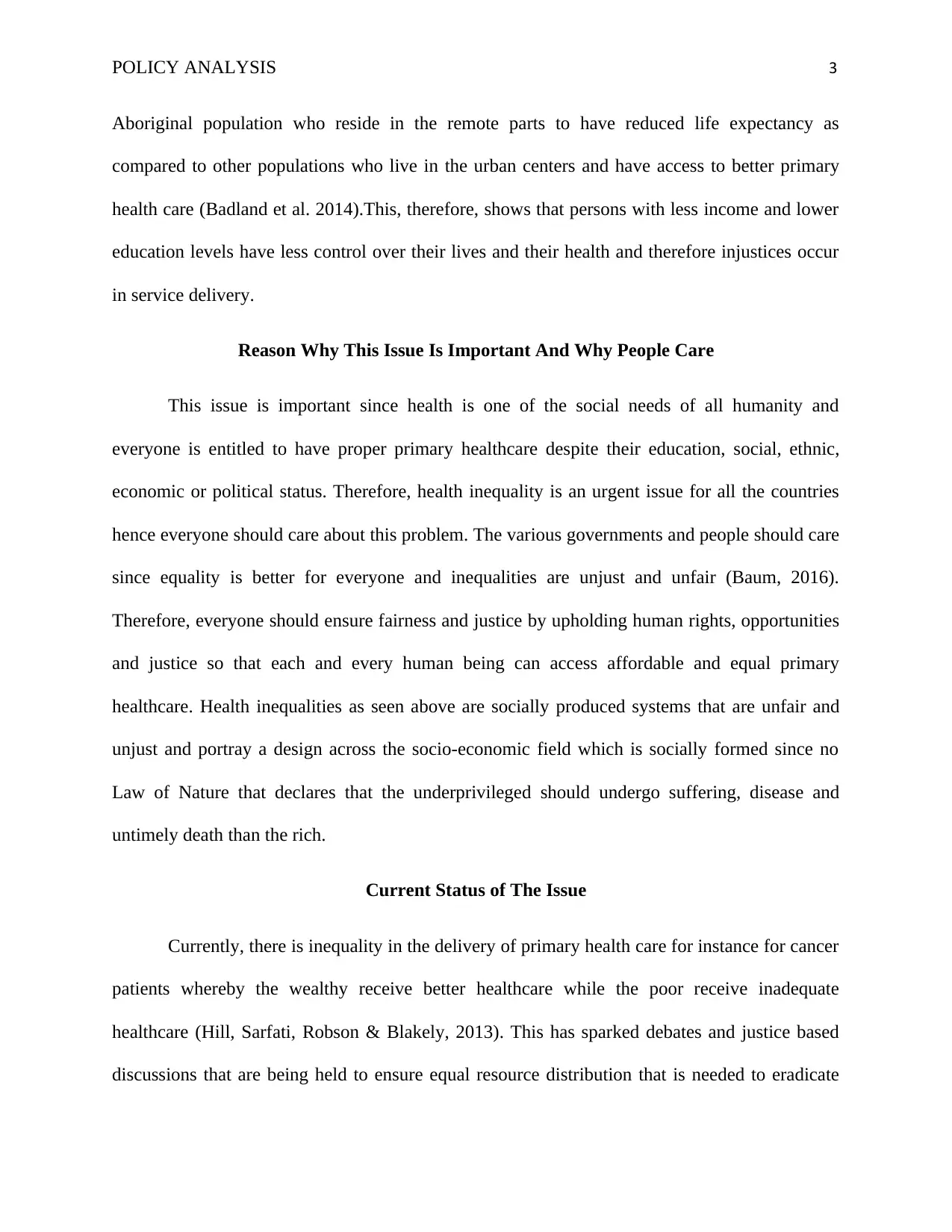
POLICY ANALYSIS 3
Aboriginal population who reside in the remote parts to have reduced life expectancy as
compared to other populations who live in the urban centers and have access to better primary
health care (Badland et al. 2014).This, therefore, shows that persons with less income and lower
education levels have less control over their lives and their health and therefore injustices occur
in service delivery.
Reason Why This Issue Is Important And Why People Care
This issue is important since health is one of the social needs of all humanity and
everyone is entitled to have proper primary healthcare despite their education, social, ethnic,
economic or political status. Therefore, health inequality is an urgent issue for all the countries
hence everyone should care about this problem. The various governments and people should care
since equality is better for everyone and inequalities are unjust and unfair (Baum, 2016).
Therefore, everyone should ensure fairness and justice by upholding human rights, opportunities
and justice so that each and every human being can access affordable and equal primary
healthcare. Health inequalities as seen above are socially produced systems that are unfair and
unjust and portray a design across the socio-economic field which is socially formed since no
Law of Nature that declares that the underprivileged should undergo suffering, disease and
untimely death than the rich.
Current Status of The Issue
Currently, there is inequality in the delivery of primary health care for instance for cancer
patients whereby the wealthy receive better healthcare while the poor receive inadequate
healthcare (Hill, Sarfati, Robson & Blakely, 2013). This has sparked debates and justice based
discussions that are being held to ensure equal resource distribution that is needed to eradicate
Aboriginal population who reside in the remote parts to have reduced life expectancy as
compared to other populations who live in the urban centers and have access to better primary
health care (Badland et al. 2014).This, therefore, shows that persons with less income and lower
education levels have less control over their lives and their health and therefore injustices occur
in service delivery.
Reason Why This Issue Is Important And Why People Care
This issue is important since health is one of the social needs of all humanity and
everyone is entitled to have proper primary healthcare despite their education, social, ethnic,
economic or political status. Therefore, health inequality is an urgent issue for all the countries
hence everyone should care about this problem. The various governments and people should care
since equality is better for everyone and inequalities are unjust and unfair (Baum, 2016).
Therefore, everyone should ensure fairness and justice by upholding human rights, opportunities
and justice so that each and every human being can access affordable and equal primary
healthcare. Health inequalities as seen above are socially produced systems that are unfair and
unjust and portray a design across the socio-economic field which is socially formed since no
Law of Nature that declares that the underprivileged should undergo suffering, disease and
untimely death than the rich.
Current Status of The Issue
Currently, there is inequality in the delivery of primary health care for instance for cancer
patients whereby the wealthy receive better healthcare while the poor receive inadequate
healthcare (Hill, Sarfati, Robson & Blakely, 2013). This has sparked debates and justice based
discussions that are being held to ensure equal resource distribution that is needed to eradicate
⊘ This is a preview!⊘
Do you want full access?
Subscribe today to unlock all pages.

Trusted by 1+ million students worldwide
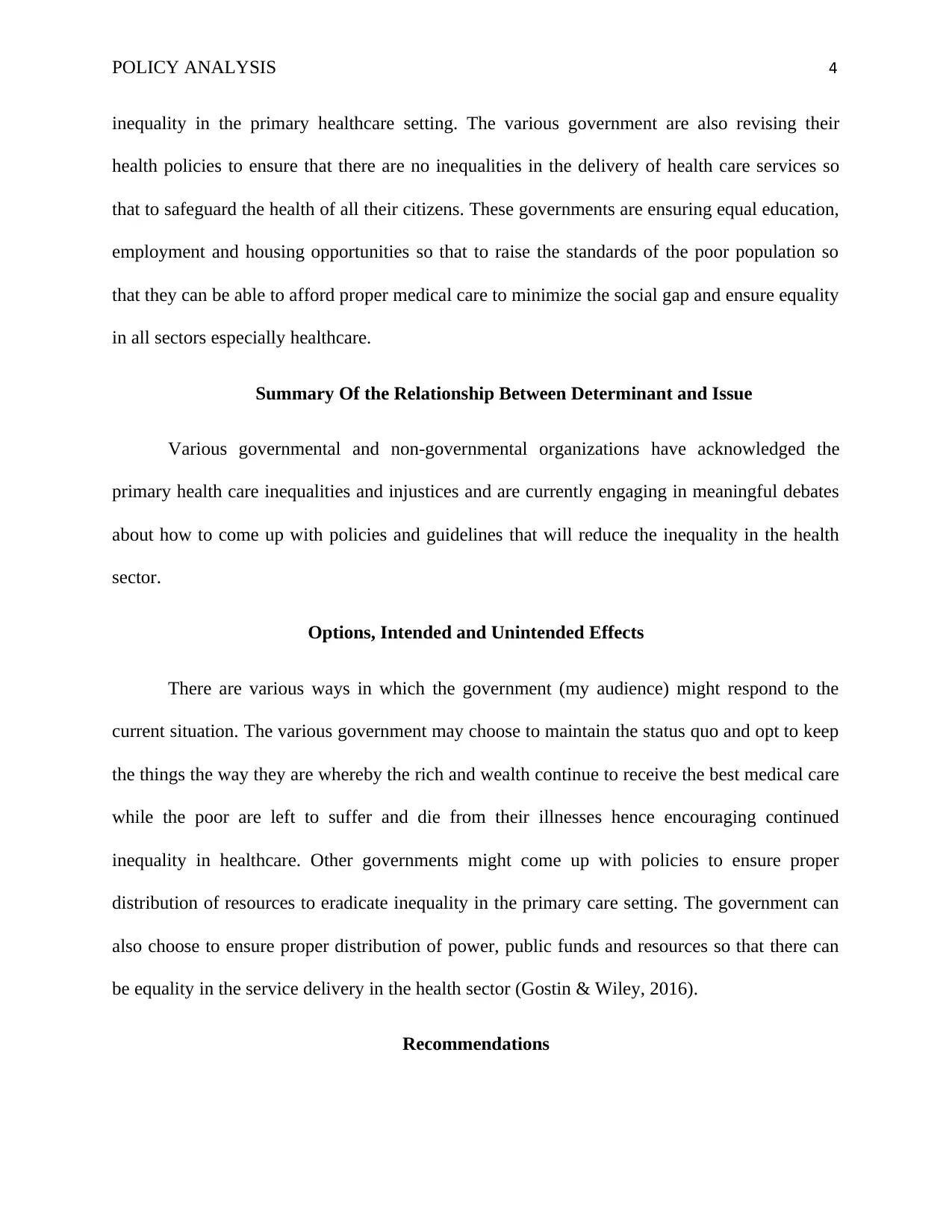
POLICY ANALYSIS 4
inequality in the primary healthcare setting. The various government are also revising their
health policies to ensure that there are no inequalities in the delivery of health care services so
that to safeguard the health of all their citizens. These governments are ensuring equal education,
employment and housing opportunities so that to raise the standards of the poor population so
that they can be able to afford proper medical care to minimize the social gap and ensure equality
in all sectors especially healthcare.
Summary Of the Relationship Between Determinant and Issue
Various governmental and non-governmental organizations have acknowledged the
primary health care inequalities and injustices and are currently engaging in meaningful debates
about how to come up with policies and guidelines that will reduce the inequality in the health
sector.
Options, Intended and Unintended Effects
There are various ways in which the government (my audience) might respond to the
current situation. The various government may choose to maintain the status quo and opt to keep
the things the way they are whereby the rich and wealth continue to receive the best medical care
while the poor are left to suffer and die from their illnesses hence encouraging continued
inequality in healthcare. Other governments might come up with policies to ensure proper
distribution of resources to eradicate inequality in the primary care setting. The government can
also choose to ensure proper distribution of power, public funds and resources so that there can
be equality in the service delivery in the health sector (Gostin & Wiley, 2016).
Recommendations
inequality in the primary healthcare setting. The various government are also revising their
health policies to ensure that there are no inequalities in the delivery of health care services so
that to safeguard the health of all their citizens. These governments are ensuring equal education,
employment and housing opportunities so that to raise the standards of the poor population so
that they can be able to afford proper medical care to minimize the social gap and ensure equality
in all sectors especially healthcare.
Summary Of the Relationship Between Determinant and Issue
Various governmental and non-governmental organizations have acknowledged the
primary health care inequalities and injustices and are currently engaging in meaningful debates
about how to come up with policies and guidelines that will reduce the inequality in the health
sector.
Options, Intended and Unintended Effects
There are various ways in which the government (my audience) might respond to the
current situation. The various government may choose to maintain the status quo and opt to keep
the things the way they are whereby the rich and wealth continue to receive the best medical care
while the poor are left to suffer and die from their illnesses hence encouraging continued
inequality in healthcare. Other governments might come up with policies to ensure proper
distribution of resources to eradicate inequality in the primary care setting. The government can
also choose to ensure proper distribution of power, public funds and resources so that there can
be equality in the service delivery in the health sector (Gostin & Wiley, 2016).
Recommendations
Paraphrase This Document
Need a fresh take? Get an instant paraphrase of this document with our AI Paraphraser
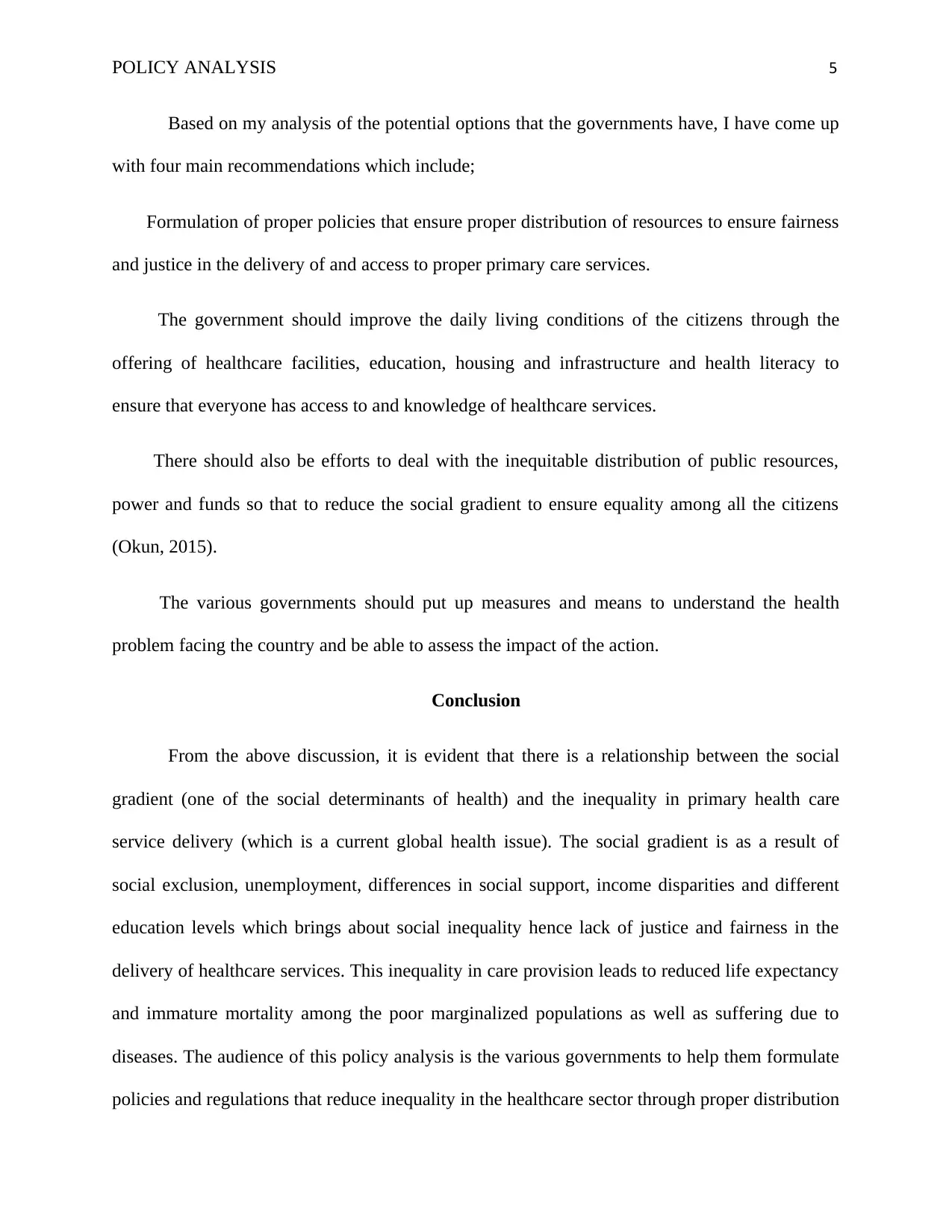
POLICY ANALYSIS 5
Based on my analysis of the potential options that the governments have, I have come up
with four main recommendations which include;
Formulation of proper policies that ensure proper distribution of resources to ensure fairness
and justice in the delivery of and access to proper primary care services.
The government should improve the daily living conditions of the citizens through the
offering of healthcare facilities, education, housing and infrastructure and health literacy to
ensure that everyone has access to and knowledge of healthcare services.
There should also be efforts to deal with the inequitable distribution of public resources,
power and funds so that to reduce the social gradient to ensure equality among all the citizens
(Okun, 2015).
The various governments should put up measures and means to understand the health
problem facing the country and be able to assess the impact of the action.
Conclusion
From the above discussion, it is evident that there is a relationship between the social
gradient (one of the social determinants of health) and the inequality in primary health care
service delivery (which is a current global health issue). The social gradient is as a result of
social exclusion, unemployment, differences in social support, income disparities and different
education levels which brings about social inequality hence lack of justice and fairness in the
delivery of healthcare services. This inequality in care provision leads to reduced life expectancy
and immature mortality among the poor marginalized populations as well as suffering due to
diseases. The audience of this policy analysis is the various governments to help them formulate
policies and regulations that reduce inequality in the healthcare sector through proper distribution
Based on my analysis of the potential options that the governments have, I have come up
with four main recommendations which include;
Formulation of proper policies that ensure proper distribution of resources to ensure fairness
and justice in the delivery of and access to proper primary care services.
The government should improve the daily living conditions of the citizens through the
offering of healthcare facilities, education, housing and infrastructure and health literacy to
ensure that everyone has access to and knowledge of healthcare services.
There should also be efforts to deal with the inequitable distribution of public resources,
power and funds so that to reduce the social gradient to ensure equality among all the citizens
(Okun, 2015).
The various governments should put up measures and means to understand the health
problem facing the country and be able to assess the impact of the action.
Conclusion
From the above discussion, it is evident that there is a relationship between the social
gradient (one of the social determinants of health) and the inequality in primary health care
service delivery (which is a current global health issue). The social gradient is as a result of
social exclusion, unemployment, differences in social support, income disparities and different
education levels which brings about social inequality hence lack of justice and fairness in the
delivery of healthcare services. This inequality in care provision leads to reduced life expectancy
and immature mortality among the poor marginalized populations as well as suffering due to
diseases. The audience of this policy analysis is the various governments to help them formulate
policies and regulations that reduce inequality in the healthcare sector through proper distribution
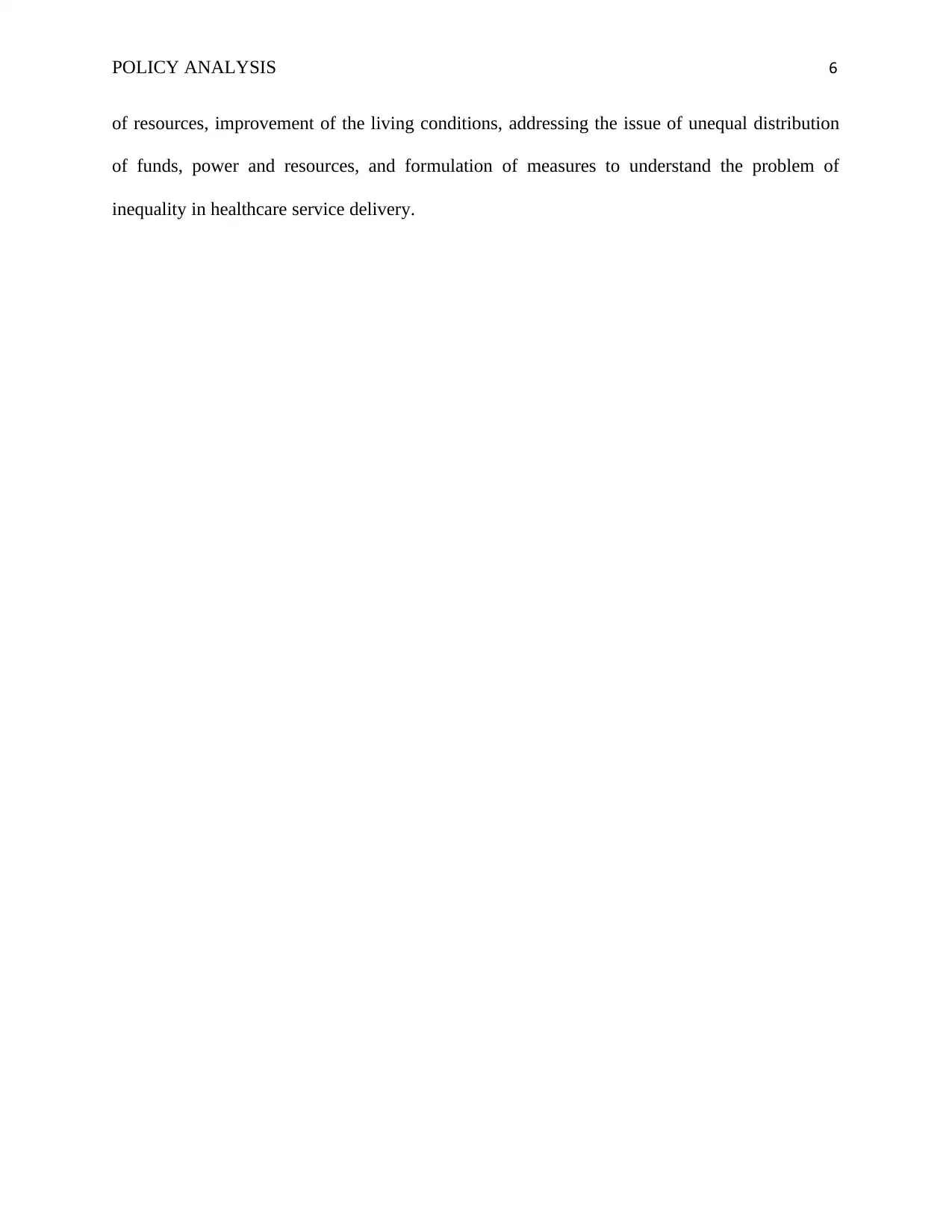
POLICY ANALYSIS 6
of resources, improvement of the living conditions, addressing the issue of unequal distribution
of funds, power and resources, and formulation of measures to understand the problem of
inequality in healthcare service delivery.
of resources, improvement of the living conditions, addressing the issue of unequal distribution
of funds, power and resources, and formulation of measures to understand the problem of
inequality in healthcare service delivery.
⊘ This is a preview!⊘
Do you want full access?
Subscribe today to unlock all pages.

Trusted by 1+ million students worldwide
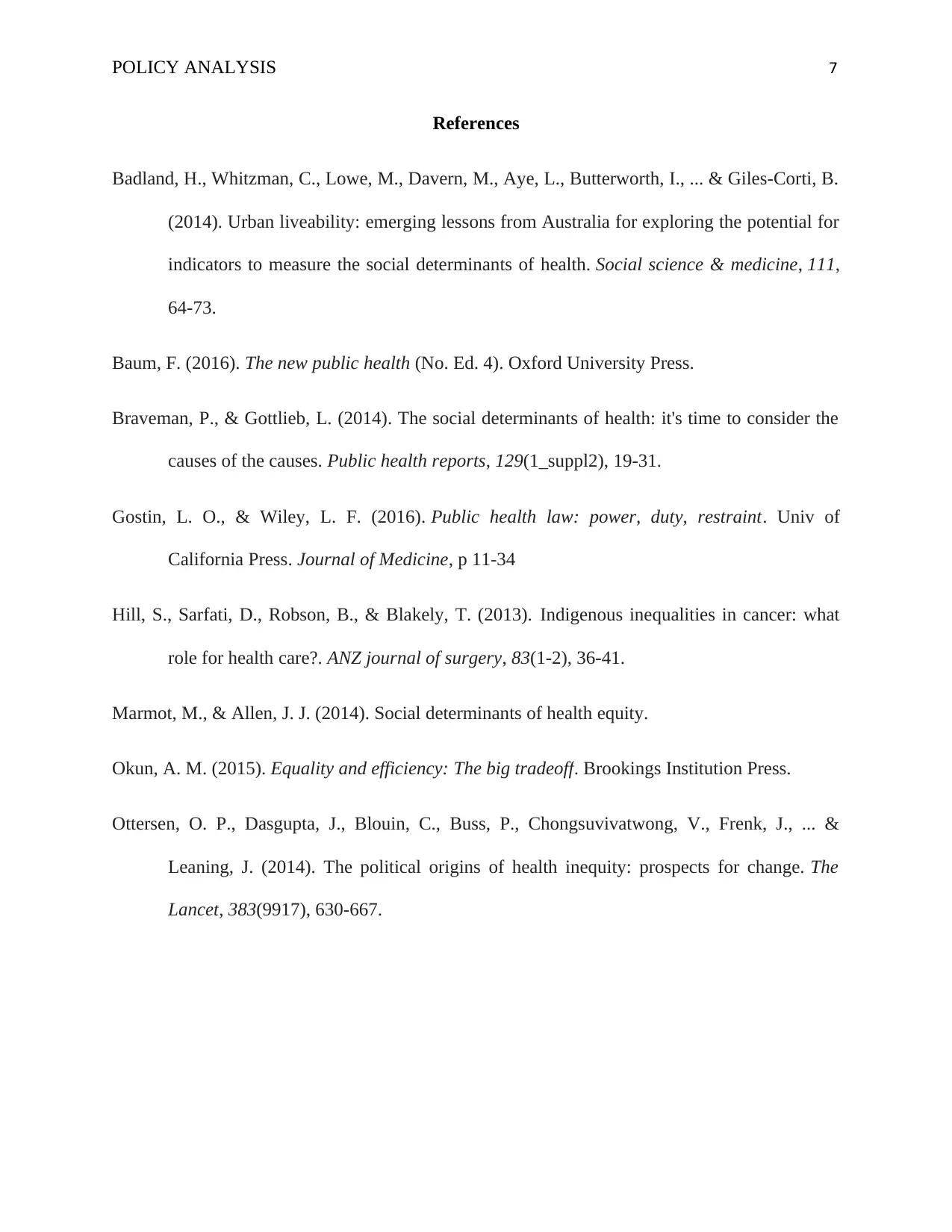
POLICY ANALYSIS 7
References
Badland, H., Whitzman, C., Lowe, M., Davern, M., Aye, L., Butterworth, I., ... & Giles-Corti, B.
(2014). Urban liveability: emerging lessons from Australia for exploring the potential for
indicators to measure the social determinants of health. Social science & medicine, 111,
64-73.
Baum, F. (2016). The new public health (No. Ed. 4). Oxford University Press.
Braveman, P., & Gottlieb, L. (2014). The social determinants of health: it's time to consider the
causes of the causes. Public health reports, 129(1_suppl2), 19-31.
Gostin, L. O., & Wiley, L. F. (2016). Public health law: power, duty, restraint. Univ of
California Press. Journal of Medicine, p 11-34
Hill, S., Sarfati, D., Robson, B., & Blakely, T. (2013). Indigenous inequalities in cancer: what
role for health care?. ANZ journal of surgery, 83(1-2), 36-41.
Marmot, M., & Allen, J. J. (2014). Social determinants of health equity.
Okun, A. M. (2015). Equality and efficiency: The big tradeoff. Brookings Institution Press.
Ottersen, O. P., Dasgupta, J., Blouin, C., Buss, P., Chongsuvivatwong, V., Frenk, J., ... &
Leaning, J. (2014). The political origins of health inequity: prospects for change. The
Lancet, 383(9917), 630-667.
References
Badland, H., Whitzman, C., Lowe, M., Davern, M., Aye, L., Butterworth, I., ... & Giles-Corti, B.
(2014). Urban liveability: emerging lessons from Australia for exploring the potential for
indicators to measure the social determinants of health. Social science & medicine, 111,
64-73.
Baum, F. (2016). The new public health (No. Ed. 4). Oxford University Press.
Braveman, P., & Gottlieb, L. (2014). The social determinants of health: it's time to consider the
causes of the causes. Public health reports, 129(1_suppl2), 19-31.
Gostin, L. O., & Wiley, L. F. (2016). Public health law: power, duty, restraint. Univ of
California Press. Journal of Medicine, p 11-34
Hill, S., Sarfati, D., Robson, B., & Blakely, T. (2013). Indigenous inequalities in cancer: what
role for health care?. ANZ journal of surgery, 83(1-2), 36-41.
Marmot, M., & Allen, J. J. (2014). Social determinants of health equity.
Okun, A. M. (2015). Equality and efficiency: The big tradeoff. Brookings Institution Press.
Ottersen, O. P., Dasgupta, J., Blouin, C., Buss, P., Chongsuvivatwong, V., Frenk, J., ... &
Leaning, J. (2014). The political origins of health inequity: prospects for change. The
Lancet, 383(9917), 630-667.
1 out of 7
Related Documents
Your All-in-One AI-Powered Toolkit for Academic Success.
+13062052269
info@desklib.com
Available 24*7 on WhatsApp / Email
![[object Object]](/_next/static/media/star-bottom.7253800d.svg)
Unlock your academic potential
Copyright © 2020–2025 A2Z Services. All Rights Reserved. Developed and managed by ZUCOL.





